Menus
- Sporty for big cube bikers
- In the saddle
- The city
- On motorways and 4 lanes
- Departmental
- Comfort
- Consumption
- Convenience
- Conclusion
Sporty for big cube bikers
The Kawasaki 300 Ninja succeeded the 250 Ninja in 2013. While the 250 was a nice little bike, the 300 underwent a bodybuilding cure with a more imposing fairing, a slightly wider rear tire and 50cc more and it is almost everything.
The 250 took the look of the ER6F, the 300 plays the sporting card by taking the codes of the ZX6R and ZX10R. The "visual" sporty side is underlined with the large fairing, the large silencer, the double-stage saddle. From the front, it really looks like a ZX6R, the illusion is perfect … and thus offers a real sports car for A2 licenses.
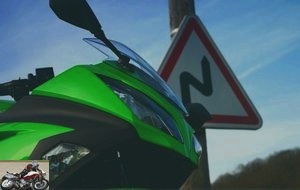
In the saddle
The 1.70meter rider normally puts his feet on the ground, suggesting an easy grip even for smaller riders. It is therefore easy to sit on the motorcycle. We then discover before our eyes a large central tachometer, with the red zone at 13,000 rpm (the maximum power is at 11,000 rpm, the maximum torque at 10,000 rpm), a screen with the speed, the gauge gasoline, the hour, the odometer and 2 partial (practical for calculating consumption).
Sitting on the motorcycle, if you are not a giant, you are very comfortable. The controls fall well to hand and feet, the saddle allows you to move if necessary and the mirrors allow you to admire (among other things) her elbows: no doubt, she is a sporty.
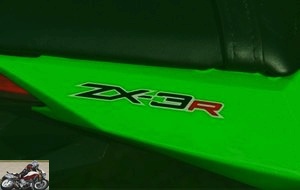
The small twin cylinder is very discreet at idle, you shift the clutch and presto, no need to wax the clutch, at 2,000rpm, you take off smoothly.
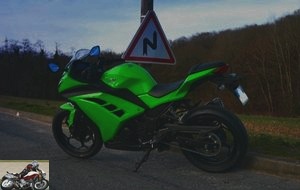
The city
The narrow tires (110 / 70-17 and 140 / 70-17) make the bike very manoeuvrable and lively. It should be noted here that on this bike, upon purchase, the original tires (IRC) were replaced by Pirelli Diablo Rosso, offering significantly more grip. Therefore, the observations that we can make later on the grip of the tires, the agility of the motorcycle or the handling in the rain should be interpreted accordingly. The bike is not very light, at 174 kg with the full tank, we are roughly at the level of the 400 sports of the beautiful era (but with 20 horses less).
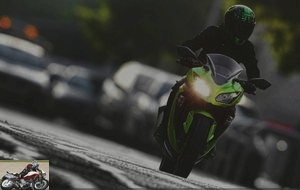
In town, the bike is very comfortable and allows you to slip through without problem. The discretion of the exhaust brings a significant peace of mind nowadays. If the mirrors allow you to admire her elbows, they also allow you to see what is happening behind without too much worry. It will just be necessary to be careful in interfile, because they are exactly at the height of the mirrors of "normal" cars (which are neither minivans, nor SUVs).
The twin is pleasant and very flexible. It resumes at 2000 revs without problem while driving daily between 4500rpm (at 50 in 4th) and 4000rpm (in 5th, at 50) in town. In 4th, so at 4500rpm, we are right on top of the speed where the engine starts to pull well and suddenly, this allows to have a good margin of recovery if necessary. Interesting indication on the instrument panel, an "ECO" indication appears when the speed / speed combination ensures optimum consumption. Quite practical, we quickly get caught up in the game and suddenly, precisely, we calm it down, the game.
Position level, we are very close to the old 500 GPZ (which was marketed, remember, for 19 years !! impressive when we see the renewal of current ranges), seated with semi-flexed legs (the pilot of the day is 1m72 ), with the bust slightly forward. Hands on the half-handlebars, the controls fall flat, the clutch is quite soft (note: on the test bike, the original levers have been replaced by "PUIG" levers offering many adjustments) and in town, the brakes are more than sufficient in normal use (reminder: a 290mm front / 220mm rear disc, each with a 2 piston caliper). On the other hand, on violent emergency braking (but without triggering the ABS), it is better to use the front AND rear brake..
So the 300 ninja is well suited to the city, but it’s time to switch from the Ninja 300 to the ZX3R. Let’s leave the city to check that the essence of the Ninja is there, that this bike is the worthy heir (or not) of the 400 ZXR.
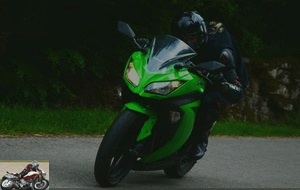
On motorways and 4 lanes
We start directly with the most painful test on an average displacement (and not necessarily pleasant on a big one), the 4 lanes and the highway..
Stalled at 120 counter in 6th gear, one hand on the tank, the engine purrs quietly (around 9,000 rpm anyway), the fairing protects quite well, the bubble too, we are well seated. In short, it’s perfect for cruising quietly to the stage. On the other hand, obviously, at this speed, it is useless to expect dazzling recoveries. You can anticipate overtaking, do not hesitate to go down 1, see 2 gears and not be afraid to approach the red zone. In this exercise, the engine is very flexible under 4000 rpm, wakes up around 4000/4500, begins to pull well at 5000 rpm, flies up frankly up to 12,000 rpm before the thrust (we are still talking about ‘a 300 anyway) then collapses. It is therefore possible to push the engine to the red zone (13,000 rpm), but it is not useful to exceed 12,000, except possibly to save 2 gear changes when approaching a bend ( but this situation is encountered more on the track than on the road).
After 1 hour of 4 lanes and 5 small roads, the test continues in the Creuse, the country of turning roads, gravel that gravel and cows crossing.
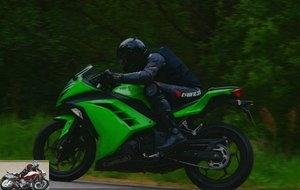
Departmental
Once rid of the saddlebags, we find the little sportswoman (yes yes, it is the insurers who say it and they make it pay dearly) ready to do battle. Good thing, the group of the day is made up of a 1200GS (Swiss version), an RSV1000R (Belgian version), a rallyman in SMT, a streetfighter, a few street triples. In short, the 300 will have a lot to do.
During the day, we will take all types of roads. From the country road numbered Cxx covered with gravel to the beautiful departmental road full of fast curves with a dream surfacing, passing bumpy "cow roads", very narrow forest roads, in short, all the possible configurations of roads to 2 lanes (sometimes only one), with relief. The sun that accompanies us (and the tires replaced by the Pirelli) have allowed us to benefit from the grip of the road without a second thought.
The position on the bike is half sporty, half roadster. Some will find it unpleasant, colleagues who have tried it have told me that they cannot position themselves, being between the 2. But they were taller than me, the average builders feeling more comfortable there than the big. It is possible to drive the 300 like a sports car, becoming one with the motorcycle. In this position, we find ourselves from time to time having the urge to go out of the knee and this happens quite naturally. It is very stable in large, fast, pleasant curves and gives a lot of confidence. The small tires and the lightness of the motorcycle (even if it is the weight of an hp4) work wonders and the size of the motorcycle does not make it too fickle..
When you leave the fast departmental roads to attack small departmental or municipal ones, those with gravel, pins that close, bumps and which are the width of a tractor (the one that leaves dirt at the entry of a bend, for example) , we appreciate all the more the mixed position.
Obviously, the engine means that you have to take care of your corner entries and exits. The technique "I brake very hard, I turn and I put gas" will not necessarily be the most efficient and pleasant. It is better to favor a coiled driving, as fluid as possible, to take advantage of the lightness of the motorcycle, while maintaining the rev counter around 6/7000 rpm / min. It is thus possible to wind around 80-90 km / h speedometer effortlessly (except on really bumpy roads, see below).
This is in fact the "absolute" rule on small roads, do not drop the tachometer below 5,000 rpm, otherwise, you have to go down 1, see 2 gears to restart. On the other hand, the pleasure of being able to flirt with the red zone without taking any risk (or so little) with his license is very appreciable, but we will come back to that. It is obvious that hoping to follow a Swiss on a 1200GS or a rallyman in a 990 KTM is illusory, but the 300 defends itself very well..
In small roads with tricky little bends, it is even possible to drive it "like a supermotard" (without stepping out): by leaning the motorcycle more than the body, which allows it to be more easily swayed to one side. on the other, to have better visibility when exiting a curve and therefore to be less surprised in the event of a change in grip. It is advisable to change the original tires before performing this kind of exercise..
On the other hand, after a certain pace, let’s say to stay around 90 on bumpy roads, and / or on roads with successions of heavy braking, the limits of the suspensions and brakes are felt. The ABS never activated during the test (except once in the gravel to test), but on hard braking, the front brake is limited, we would have liked to have a little more bite by moment (to be corrected by a change of platelets).
For the suspensions, the motorcycle is sometimes a little flying carpet. She remains healthy, but things are moving quite a bit. On the other hand, they are flexible, so comfort is preserved (compared for example to a hypersport on the same road, where the pilot has really suffered).
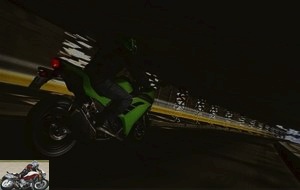
Comfort
6 hours spent on the handlebars: we did it. Verdict: the saddle is comfortable enough for long journeys, the position is not too much resting on the wrists, the original pot does not make any noise. In the end, it is the whistling of the air in the headphones that is the most tiring if you have forgotten the earplugs..
Consumption
In urban use, consumption remains reasonable, providing 10 liters around 220 km. Consumption varies depending on the pace, between 3.8 and 4.4l per 100 km on small roads with very sporty driving.
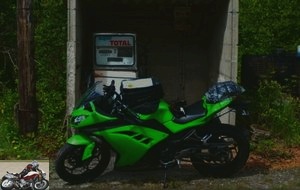
Convenience
The motorcycle has 2 hooks on the rear indicators and 2 others on the passenger footrests. Forget the seat box, it contains the Kawasaki tool kit and that’s it. The very angular sides are not the most practical for putting saddlebags, but with a little method, it is done without problem and it does not move (800 km of the test were done with the motorcycle loaded).

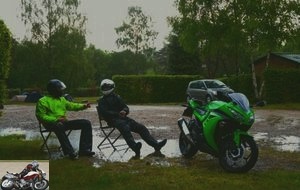
Conclusion
This bike is the worthy heir to the 400 sports. Fairly light, with an engine that likes to take turns, very manoeuvrable, it offers all the sensations on the road. It offers this very significant possibility of being able to transform a country road into a Tourist Trophy special without being outlawed at the slightest stretch. It is a very comfortable motorcycle for a ride and which will still require a little commitment to ride at a good pace didn’t realize it ").
Strong points
- He’s a ninja
- Motor
- Liveliness
- Comfort
- Consumption
Weak points
- Especially in insurance
- Brakes a little soft in sports use
- price
Kawasaki Ninja 300 technical sheet
Related articles
-
A new little sports car accessible to A2 licenses Twin cylinder in-line, 399 cm3, 45 hp at 10,000 rpm, 38 Nm at 8,000 rpm, 168 kilos, from € 5,999…
-
Roadster with Sugomi sauce or decarenated sports car A2 licenses have the choice between large bridles, sometimes very badly bridled, and smaller ones,…
-
40 horses at 11,500 rpm 25.7 Nm, 175 kilos with full tank, two colors, € 5,799 An easy and sparkling little trail: what if life on a motorcycle was as…
-
Evolution or revolution of the ER6-f with the in-line twin of 649 cm3, 68 horsepower for 193 kilos A more sporty look but, paradoxically, a gain in…
-
Kawasaki VN 1600 custom motorcycle test
The boat The VN 1600 is the novelty of 2003 in terms of custom. Since the first Sumo 1500 presented in 1988, the custom largely won in power, handling…
-
Kawasaki Z1000 motorcycle test
The Kawasaki Z1000 represents the master stroke of the Akashi manufacturer. Used to its sporting tradition, Kawasaki was rather discreet if not…
-
The cruise missile – A test carried out by Jean-Marie Blanc. Released in 2000 as a replica to the Suzuki Hayabusa, the ZX-12R is the ultimate evolution…
-
Kawasaki Z H2 Supercharged motorcycle test
200 hp, 14 mkg at 8,500 rpm, 239 kg all full, 17,099 € Put some salt ! Fifteen days of driving with the Kawasaki Z H2? I say it bluntly, it takes less to…
-
The balance Euro5 parallel twin, 649 cm3, 68 hp and 64 Nm, 188 kg full made, A2 compatible In life and in its evolution, the Kawasaki Z650 follows in the…
-
Ninja Apprentice On paper, we imagine that the Kawasaki Ninja 250 R, with only 33 horsepower, will only appeal to the young drivers. After a week of…
I don’t like this rikiki lighthouse at all. It distorts the line of the bike.
And if there was only the lighthouse …… Finally good, it takes for everyone eh …..